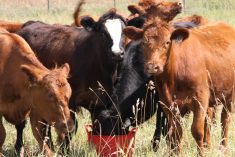REGINA – The announcer at Canadian Western Agribition called them crazy.
So did spectators during the thunderous applause that followed the Cowboy Stuntmen show Nov. 25.
But members of the rodeo stunt team demurred.
“It’s no worse than bull riding or bronc riding. It’s just they’ve never seen it,” said Sylvain Bourgeois of Wildtime Productions, which organized the Cowboy Stuntmen’s first appearance at Agribition.
“People can’t really relate to rodeo events now. If you’re from the city and that’s your first rodeo, you don’t really understand what’s happening, but a race is really easy to understand. After two or three they pick up and say, ‘oh this is crazy,’ and last night we had a few wrecks. That makes it a little more crazy.”
Read Also

Organic farmers urged to make better use of trade deals
Organic growers should be singing CUSMA’s praises, according to the Canadian Chamber of Commerce.
Based in Quebec, Wildtime Productions entertains at Canadian rodeos with stunt-riding demonstrations in race-styled events. The competition evolved from pony express stories of the Wild West and Hollywood stunts.
The pick-up race event simulates a rescue in which horse and rider race around poles in two corners of the arena to pick up the rider’s “shot” partner before completing the circuit. The rescued rider can grab hold of pommel, saddle horn or rider as the horse gallops by.
The exchange race involves the first rider jumping off his speeding horse while the second rider, in full-flight, tries to grab and pull himself on the horse within a designated exchange zone.
A large foam pad set up along the arena’s metal side rails helps protect riders from injury if they miscalculate or fall off the horse.
“It’s all about timing and agility,” said Dany Poirier, who has been racing for 12 years.
“You use the force of the horse and the speed to propel you on the back, but you don’t want to stop the horse, you don’t want to slow him down.”
The cushion doesn’t prevent all injuries. Poirier has broken his ankle from hitting the pad at full speed.
Bourgeois said jumpers have had lots of accidents and injuries.
“Ten years ago we didn’t have that (foam cushion) so there were lots of broken legs. My brother-in-law can tell you about accidents. He’s got broken shoulders, broken legs, broken everywhere,” he said.
“You’re going full blast and you’re relying on the ground being good. Anything can happen: you lose a shoe or something and you slip and that’s it. You can’t be scared because if you are scared, you’re going to think about it.”
The fast-paced performance is popular in Quebec, where it originated 50 years ago.
“In Quebec there weren’t any big ranches. There wasn’t any rodeo at the time. No bucking horse, but there were a lot of horses and horsemen and they wanted something a little more crazy,” Bourgeois said. “A lot of people think it’s an act. It’s not an act, it’s a competition, it’s an event.”
He said riders need a fast horse if they want to win money, and there’s a lot of money to be won.
“Those guys, in the course of a summer, can make like $25,000, which is a good hobby for a guy who owns a horse. Those guys are weekend warriors.”















